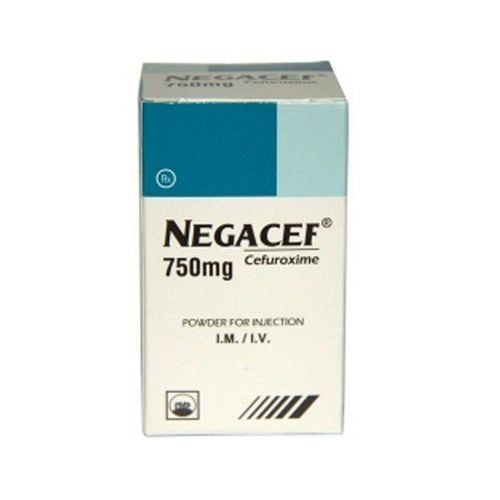This is an automatically translated article.
Negacef 500 contains Cefuroxime, a 2nd generation Cephalosporin antibiotic and is used to treat mild to moderate infections. The drug can be prescribed in the treatment of many types of infections, including respiratory, urinary, and genitourinary.
1. What is negacef 500?
The active ingredient Negacef 500 is Cefuroxime axetil. Cefuroxime axetil is a prodrug of Cefuroxime, a 2nd generation cephalosporin and is used to treat mild to moderate bacterial infections. The mechanism of action of Cefuroxime is by inhibiting bacterial cell wall synthesis by binding to PBPs (protein binding penicillins), thereby inhibiting the final transpeptidation step in bacterial cell wall peptidoglycan synthesis. . Bacteria are eventually lysed by the continued action of autolytic enzymes.After oral administration, the drug is absorbed from the gastrointestinal tract and rapidly hydrolyzed in the intestine to release Cefuroxime into the systemic circulation. Peak serum concentrations are reached approximately 2 to 3 hours after dosing. Cefuroxime is not metabolized and is eliminated by the kidneys. The half-life of the drug ranges from 1 to 1.5 hours.
2. What are the effects of Negacef 500?
The drug can be used in the following cases:
Lower respiratory tract infections such as acute and chronic bronchitis; Upper respiratory tract infections such as ear-nose-throat infections (sinusitis, otitis media, tonsillitis, pharyngitis); Uncomplicated urogenital infections (pyelonephritis, cystitis, urethritis); Uncomplicated skin and soft tissue infections such as boils, impetigo,...; The use of the drug Negacef 500 can be used to treat gonorrhea, uncomplicated acute urethritis caused by gonococcal disease and cervicitis.

Thuốc Negacef 500 được chỉ định trong điều trị nhiều loại nhiễm trùng, bao gồm hô hấp, tiết niệu, sinh dục
3. What is the dose of Negacef?
The drug is taken orally. Dosage depends on age and infectious pathology, specifically as follows:
Adults:
Bronchitis: dose 500mg x 2 times/day; In most other infections: 250mg twice daily; Uncomplicated urinary tract infections: 125mg x 2 times/day; Uncomplicated gonorrhea: a single dose of 1g is recommended. Children:
The usual recommended dose is 125mg x 2 times/day or 10mg/kg x 2 times/day, up to a maximum of 250mg/day. Children aged 2 years and older with otitis media: 250mg x 2 times/day or 15mg/kg x 2 times/day can be used, up to 500mg/day. The recommended dose for patients with renal insufficiency depends on the creatinine clearance:
Creatinine clearance ≥ 30ml/min: No dose adjustment required, usual dose is 125 - 500mg divided 2 times/day; Creatinine clearance 10 - 29ml/min: Use usual dose but once daily; Creatinine clearance <10ml/min: Use usual dose but dosing interval is every 2 days. Patients on hemodialysis: Administer the usual dose at the end of each dialysis session. Patients should note that the above dosage is for reference only. The specific dose of Negacef 500 will vary depending on the body, the location of the infection and the severity of the disease. Therefore, you should not self-medicate, but consult your doctor or pharmacist to get the right dose.
4. What to do in case of overdose Negacef?
When there are signs of drug overdose, it is necessary to pay attention to protect the patient's respiratory tract, support ventilation and give fluids if necessary. If seizures develop, discontinue use immediately, and anticonvulsant therapy may be instituted if appropriate. Hemodialysis can remove drugs from the blood, but most treatment is supportive or symptomatic relief from an overdose.

Liều dùng thuốc Negacef 500 cụ thể sẽ thay đổi tùy thuộc vào thể trạng, vị trí nhiễm trùng
5. What are the side effects of Negacef?
When using Negacef 500, you may experience some unwanted effects (ADRs), including:
Common, ADR > 1/100
Diarrhea; Nodular skin rash. Uncommon, 1/1000 < ADR < 1/100
Anaphylactic reaction; Candida infection ; Leukopenia, eosinophilia, neutropenia; Positive Coombs test; Diaper rash in children ; Nausea, vomiting, bad taste; Urticaria, itching; Local thrombophlebitis; Increased serum creatinine. Rarely, 1/10000 < ADR < 1/1000
Fever, chest pain, tachycardia; Hemolytic anemia ; Pseudomembranous colitis; Erythema, urticaria, Stevens-Johnson syndrome, toxic epidermal necrolysis; Cholestatic jaundice, mild elevation of AST, ALT; Nephrotoxicity with transient elevation of serum creatinine, blood urea or interstitial nephritis; Convulsions (especially if the dose is high and the patient has renal failure); Headache, agitation, joint pain; Painful urination, bleeding and pain in the urethra. When experiencing side effects of the drug, it is necessary to stop using it and notify the doctor or go to the nearest medical facility for prompt treatment.

Khi sử dụng thuốc Negacef 500, bạn có thể gặp một số tác dụng không mong muốn
6. What are the precautions when using Negacef?
Some notes during the use of Negacef 500 are:
The drug can increase INR, especially in patients with nutritional deficiencies, prolonged treatment, liver or kidney disease; Hypersensitivity Reactions: Serious and sometimes fatal hypersensitivity (anaphylactic) reactions have been reported in patients receiving Beta-lactams. Before initiating treatment, carefully investigate a history of allergy to penicillins, cephalosporins, or hypersensitivity to other allergens. Use with caution in patients who are allergic to penicillin or other beta-lactam drugs. If an allergic reaction occurs, discontinue the drug immediately and initiate appropriate therapy; Superinfection: Prolonged use can lead to fungal or bacterial superinfections, including C. difficile diarrhea and pseudomembranous colitis; Use caution when administering Negacef to patients with a history of colitis; Patients with renal impairment: Use with caution in patients with renal impairment, adjust dosage in case of severe renal impairment; Convulsions: Use with caution in patients with a history of seizures. Cephalosporins have been associated with convulsions, particularly in patients with renal impairment for whom no dose adjustment is required. Discontinue the drug immediately if convulsions occur; Pregnancy: Cefuroxime crosses the placenta but generally does not increase the risk of birth defects or adverse outcomes for the fetus or mother. However, pregnant patients should only use the drug according to the doctor's prescription; Lactation: Cefuroxime is excreted in human milk. According to the manufacturer, the decision to breastfeed during treatment should weigh the benefits and risks (benefits of treatment to the mother, risk of drug exposure to the infant, and benefits of breastfed babies). Cephalosporin antibiotics are generally considered compatible with breast-feeding when used at commonly recommended doses. Patients should consult their doctor before taking any medication during lactation; Drug Interactions: There are many drug interactions that can occur when Cefuroxime is taken with other drugs. For example, Cephalosporins may enhance the nephrotoxic effects of aminoglycosides and decrease serum aminoglycoside concentrations. In addition, antacids and antihistamines may reduce serum concentrations of Cefuroxime. Treat by administering Cefuroxime axetil approximately 2 hours after administration of an antacid or H2 antihistamine. High doses of probenecid have the potential to decrease renal clearance of cefuroxime, increasing plasma concentrations of cefuroxime. It is best to inform your healthcare provider about all medications you are taking for appropriate advice; Store Negacef in a cool, dry place (below 30oC), away from direct light. In summary, Negacef is an antibiotic used to treat a wide range of mild to moderate bacterial infections. The drug can cause many unwanted effects, especially allergies, anaphylaxis. Therefore, patients need to consult a doctor or pharmacist before using the drug to avoid dangerous complications.
Please dial HOTLINE for more information or register for an appointment HERE. Download MyVinmec app to make appointments faster and to manage your bookings easily.













